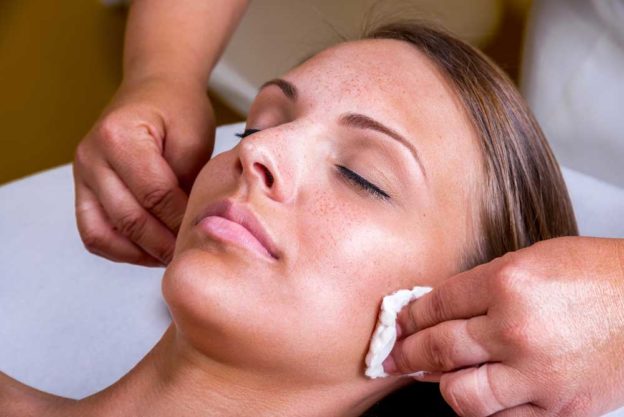When you hear about skin peels, you might think of what happened to Samantha in Sex and the City: a red, peeling, melted-looking complexion.
Chemical skin peeling treatments often have a bad reputation. They can seem scary or damaging, but just how much truth is there to these fears?
A chemical face peel is a chemical exfoliant that’s applied to the skin to strip away the skin and make your skin cleaner, brighter, and tighter.
Just like any advanced skin care treatment, there are benefits and risks involved. But, a skin peel is nothing to be afraid of.
As long as the treatment is handled by a professional, you can use a face peeling treatment to reveal a new layer of glowing skin. Before you commit, it’s important that you understand the risks and benefits.
There are a lot of myths surrounding chemical peels. Sorting out fact from fiction is the first step towards deciding if this is the right treatment for you. Let’s take a look at a few of these misconceptions–and the truth behind them.
Myth #1: Chemicals Are Bad For Your Skin
Don’t let the word ‘chemical’ scare you away.
Not all chemicals are bad. Skin peeling treatments are made of chemicals, but so are other medications like over the counter painkillers. They’re a necessary part of taking better care of our bodies and skin.
Also, most chemicals come from natural sources. For example, glycolic acid comes from sugar cane and lactic acid comes from milk.
As long as they’re handled by a professional, these chemical peeling products are completely safe to use.
Myth #2: Chemical Peels Are Just For ‘Problem’ Skin
You don’t have a severe skin condition to get professional help.
Chemical peels can benefit all skin types, including sensitive skin. A skin peel is a resurfacing treatment. While your skin has a normal cell turnover rate of 21 to 28 days, this rate can slow down as we age, or skin can get clogged.
With a skin peel, you can chemically exfoliate the skin by breaking down the dead skin cells that remain on your face. This stimulates cell turnover and leaves you with fresher, brighter skin.
It can help improve skin texture, tone, brightness and acne breakouts, and it has antioxidant and anti-inflammatory abilities as well. Here’s a full list of what a chemical face peel can help you with:
- Acne
- Sun or age spots
- Scars
- Blemishes
- Dull skin
- Congestion
- Rough or uneven texture
- Fine lines
- Pigmentation
Myth #3: You Need Significant Time to Recover After a Peel
While the chemical exfoliation needs to be strong enough to break down the skin cells on your face, it’s paired with gentler anti-inflammatory ingredients which keep your skin moisturized and healthy.
These kinds of peels are sometimes even called the ‘lunchtime peel’ or the ‘red carpet peel’ because of how quickly you recover. It’s often used right before big events.
If you opt for a deeper exfoliating peel, they might leave some slight redness or visible peeling. But other options include gentler alpha and beta hydroxy peels, which won’t show any signs of visible exfoliation.
You have a lot of flexibility when it comes to chemical face peels. If you don’t mind a little downtime, a deeper peel can give you serious results in just one session. Doing a series of these lighter peels can give you the same effect of a deeper peel without any of the downtime.
Myth #4: You Can Do a Chemical Peel at Home
If you go online or to your local store, you might be able to find chemical peels available for purchase. While chemical peels are perfectly safe, you should never try to attempt them yourself, especially if you’re not a trained esthetician.
You won’t get the results of a professional peel and you could seriously damage or burn your skin.
Not only do you not have the resources or knowledge of a trained professional, but a lot of these at home chemical peeling kits aren’t at the same quality of a professional treatment. They are likely to be a lot harsher on your skin.
If you’re not careful, you could end up spending more money on cosmetic treatments to fix scarring or burns from an at home chemical peel gone wrong.
Myth #5: A Chemical Peel Can Fix Your Skin
While a chemical peel can repair visible damage and leave you with a glowing, brightened complexion, one treatment won’t make all your skin problems go away.
You can’t clear years of hormonal acne or scarring with a single chemical peel, as well as other skin concerns like sun damage or factors associated with aging.
Chemical peels are meant to treat the surface of the skin, including light scars, blemishes, pimples, fine line, texture, and skin tone.
It may take several treatments over a period of time to help your skin get to where you want it to be. And for some skin problems, you may need a more serious cosmetic procedure.
For the best results, you should properly moisturize your skin, drink lots of water, get at least 8 hours of sleep a night, and wear skin protection when you’re under the sun.
It’s not a one-time solution and it can’t resolve all of your skin problems in just a few minutes–but a face peeling treatment can set you on the right path towards a better complexion.
Are Skin Peeling Treatments Right For You?
Separating myths from the reality is important when it comes to chemical peels–especially since they can seem intimidating.
But these days, face peels performed by professional estheticians are perfectly safe–and can help you reveal a fresh layer of glowing, healthy skin in just a few minutes per session.
Now that you know the risks (and the benefits) involved with skin peeling treatments, it’s time to decide if it’s the right choice for you.
Looking for more advice on skin rejuvenation like facials, laser treatments, or injectibles? Check out our blog for more information!


